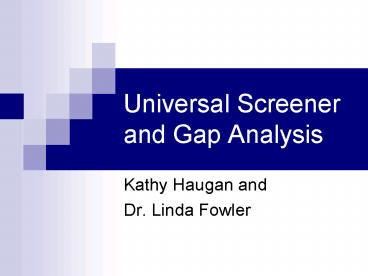Universal Screener and Gap Analysis - PowerPoint PPT Presentation
1 / 25
Title:
Universal Screener and Gap Analysis
Description:
Universal Screener and Gap Analysis Kathy Haugan and Dr. Linda Fowler Session Overview Universal Screeners and RtI District Universal Screeners Median Scores Gap ... – PowerPoint PPT presentation
Number of Views:245
Avg rating:3.0/5.0
Title: Universal Screener and Gap Analysis
1
Universal Screener and Gap Analysis
- Kathy Haugan and
- Dr. Linda Fowler
2
Session Overview
- Universal Screeners and RtI
- District Universal Screeners
- Median Scores
- Gap Analysis
- Progress Monitoring
3
Its ALL About Data
4
A Universal Screener is a basic assessment
procedure that helps identify academic
difficulties.
- Tied to academic standards
- Administered school-wide to all students
- Brief, reliable and valid
- Helps detect early problems and allocate
resources accordingly - Screening allows you to see the students
progress relative to his peers. - Use data to determine if the achievement gap is
closing
5
The role of RtI in Universal Screening
- RtI is a way of screening children, early in
their schooling, that can help educators identify
those who may not be responding to instruction.
Alexa Posny, - Assistant Secretary OSERS
- Identifies effective Tier I educational outcomes
and indicates whether about 80 of students are
achieving at expected levels. - Compares student and subgroup scores to the rest
of the grade in that school/district. - Used to make instructional decisions.
6
District Universal ScreenersReading
- FAIR Vocabulary K-2
- SAT10 2nd (Title I) and 3rd
- FCAT 4th-12th
- FAIR Maze and Word Analysis 3rd 10th
7
District Universal ScreenersMath
- SAT10 2nd (Title I) and 3rd
- District Benchmark Assessments 3rd-8th
- 4th-12th Grade FCAT
8
District Universal Screeners
- Writing
- Florida Writes 4th, 8th, 10th
- District Assessments K-10
- Behavior
- Office Discipline Referrals (ODRs)
9
A New Way of Operating
10
How to use Screening Data
- Calculate a grade level median.
- Determine whether 80 of students are at
benchmark expectation. - If not, implement Tier I Strategies for all
students. - Find your lowest 20 from the peer median on the
screener and problem solve Tier II interventions
for targeted groups. - Progress monitor and graph the groups progress.
11
Using the Median
.
- The median is the center of a distribution of
scores. - Half of the scores are above the median and half
are below. Select the data in ascending order and
choose the centered value. - Ex. 1, 4, 9. The median is 4. When there is an
even set of numbers, the median is the mean of
the two middle numbers. Ex. 2, 4, 9, 12 (4
9) / 2 6.5
12
Why the Median?
- The median is an effective way to determine an
approximate average when dealing with a set of
numbers that could be skewed by outliers. - The median is not sensitive to extreme scores.
13
Example FCAT Scores
14
(No Transcript)
15
(No Transcript)
16
Gap Analysis
- Gap Analysis is a tool for measuring the
difference between the students current level of
achievement and the benchmark expectation or the
peer level of performance. - A Gap Analysis is determined by dividing the
expected benchmark by current student/subgroup
performance. A significant gap is 1.5 or above.
17
Steps and Examples of Gap Analysis
- Expectation is 68 WPM. Divide 68 wpm by 20 wpm
(current student performance) 68/20 3.4 The gap
this student has to close by the end of the year
is 3.4. - A significant gap is 1.5 or above (depending upon
scores, using 1.25 may be acceptable). - Formula Expected Score/ Student Score
- Peer Median/Student Score
- Expected Score/Peer Median
18
Calculating What is Needed to Close the Gap
- Determine the student needs in order to close the
gap. Subtract the students current performance
from the expected benchmark. For example - 90 wpm (spring expectation) 20 wpm (student
score) 70 wpm (necessary to close gap) - Determine realistic progress for student. 70 wpm
divided by 15 week of intervention 4.6 wpm of
weekly gain necessary.
19
Practice for Gap Analysis
- Benchmark standard score on Mazes
- is 100.
- Peer Median SS on Mazes is 89.
- Student Standard Score on Maze is 62.
- Do the gap analysis for each of these areas
according to the formulas.
20
Answers to Gap Analysis Practice
- Benchmark/Peer 110/89 1.23
- Benchmark/Student 110/62 1.77
- Peer Median/Student 89/62 1.43
21
Progress Monitoring
- FAIR Tool Kit
- dibels.uoregon.edu
22
Graphing Reading Groups
Scores
Weeks
23
Progress Monitoring Data is used to evaluate the
effectiveness of the intervention
- Gap analysis is conducted to determine a need for
intervention and to provide students Tier II
interventions in the areas of need compared to
their peers and the benchmark expectation. - When utilizing a progress monitoring tool, such
as ORF, it is important to gather baseline data
on the peer or subgroup performance on this
measure by administering it to a small group of
typically performing peers.
24
What are your building level challenges?
25
Contacts
- Dr. Linda Fowler, RtI Resource Specialist
- Professional Development
- 751-6550 ext. 2218
- Kathy Haugan, RtI Resource Specialist
- Professional Development
- 761-6550 ext. 2256
- Jessica Kearbey, RtI Secretary
- Professional Development
- 761-6550 ext. 2293































